
Soho Square is a garden square in Soho, London, hosting since 1954 a de facto public park let by the Soho Square Garden Committee to Westminster City Council. It was originally called King Square after Charles II, and a much weathered statue of the monarch has stood in the square, with an extended interruption, since 1661, one year after the restoration of the monarchy.

St Ebbe's is a Church of England parish church in central Oxford. The church is within the conservative evangelical tradition and participates in the Anglican Reform movement. It has members from many nations, many of whom are students at Oxford University. The rector is Vaughan Roberts who is also an author and conference speaker.

Coade stone or Lithodipyra or Lithodipra is stoneware that was often described as an artificial stone in the late 18th and early 19th centuries. It was used for moulding neoclassical statues, architectural decorations and garden ornaments of the highest quality that remain virtually weatherproof today.

Hertford Heath is a village and civil parish near the county town of Hertford in Hertfordshire, England. The population at the 2011 Census was 2,672.

John Belcher was an English architect, and president of the Royal Institute of British Architects.

Frederick William Pomeroy was a prolific British sculptor of architectural and monumental works. He became a leading sculptor in the New Sculpture movement, a group distinguished by a stylistic turn towards naturalism and for their works of architectural sculpture. Pomeroy had several significant public works in London and elsewhere in the United Kingdom, notably in Belfast. His work in London includes the figure of Lady Justice (1905–1906) on the dome of the Old Bailey.

The Church of the Holy and Undivided Trinity with Saint Jude, Upper Chelsea, commonly called Holy Trinity Sloane Street or Holy Trinity Sloane Square, is a Church of England parish church in London, England. It was built in 1888–90 at the south-eastern side of Sloane Street, to a striking Arts and Crafts design, by the architect John Dando Sedding, and paid for by 5th Earl Cadogan, in whose London estate it lay. It replaced an earlier building only half its size which, at the time of its demolition, was less than 60 years old.
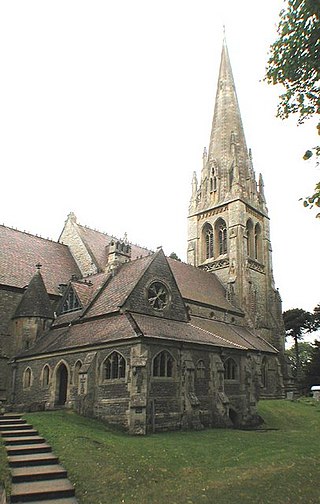
Henry Woodyer (1816–1896) was an English architect, a pupil of William Butterfield and a disciple of A. W. N. Pugin and the Ecclesiologists.
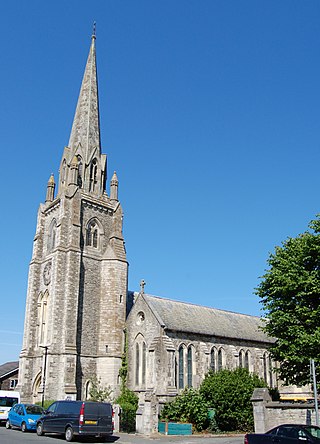
Holy Trinity Church is a former Church of England parish church located in the town of Ryde on the Isle of Wight. Opened in 1845, consecrated the following year and parished in 1863, it became the rapidly growing town's first parish church. A "fine, gracious" and "imposing" structure with a 134-foot (41 m) spire, it is visible for miles as a landmark at the northern end of the island, along with nearby All Saints' Church. The building has been used as a community centre since it closed for worship in 2014. Historic England has listed it at Grade II for its architectural and historical importance.

Onslow Square is a garden square in South Kensington, London, England.
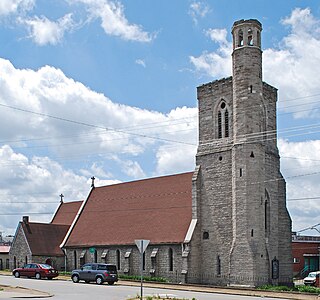
Holy Trinity Church is a historic Episcopal church at 615 6th Avenue South in Nashville, Tennessee, currently a parish of the Episcopal Diocese of Tennessee. The congregation was formed in 1849 as a mission of the nearby Christ Church Episcopal, attained parish status in 1851, and grew to around fifty members per service by the beginning of the American Civil War. During the war, the church was occupied by Federal troops and was badly damaged. After repairs, services continued and a new mission was opened on Wharf Avenue, which catered to the African American population of Nashville and soon overtook Holy Trinity in membership. After Holy Trinity lost parish status in 1895, the two missions merged and continued to serve the African American community of Nashville. Its congregation was largely made up of faculty and students from nearby Fisk University and other educational institutions. The mission reattained parish status in 1962, and the current rector is Bill Dennler.

The Parish Church of St Luke, Chelsea, is an Anglican church, on Sydney Street, Chelsea, London SW3, just off the King's Road. Ecclesiastically it is in the Deanery of Chelsea, part of the Diocese of London. It was designed by James Savage in 1819 and is of architectural significance as one of the earliest Gothic Revival churches in London, perhaps the earliest to be a complete new construction. St Luke's is one of the first group of Commissioners' churches, having received a grant of £8,333 towards its construction with money voted by Parliament as a result of the Church Building Act of 1818. The church is recorded in the National Heritage List for England as a designated Grade I listed building. The gardens of St Luke's are Grade II listed on the Register of Historic Parks and Gardens.

Holy Trinity Barnes is a Church of England church in Castelnau, Barnes, London. Its vicar is David Cooke.

Holy Trinity Church is a heritage-listed Anglican church at 39 Gordon Street, Mackay, Mackay Region, Queensland, Australia. It was designed in 1923 by Lange Leopold Powell and built by A Stonage and Sons, completing in 1926. It is also known as Holy Trinity Church Complex. It was added to the Queensland Heritage Register on 29 April 2003.

Holy Trinity Church is the parish church for the village of Weston in Hertfordshire. The church building stands to the south-east of the village on high ground, and is built of flint and coursed ironstone rubble. It was Grade I listed in 1968. In the churchyard is the supposed grave of the giant Jack o'Legs.

The Henry Wood Hall is a redundant church and orchestral rehearsal and recording studio in Trinity Church Square, Southwark, London, named after the conductor Sir Henry Wood. Formerly the Holy Trinity Church, it was designed in 1823–24 by Francis Octavius Bedford.

Holy Trinity Church is a Church of England parish church in Rotherhithe, south east London, within the diocese of Southwark.
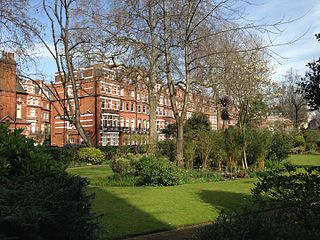
Egerton Gardens is a street and communal garden, regionally termed a garden square, in South Kensington, London SW3.
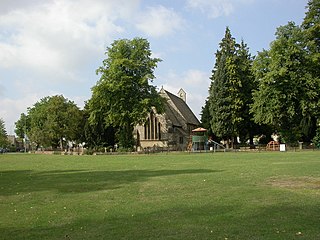
Holy Trinity Church, Wood Green, is a Grade II listed Victorian church in Witney, Oxfordshire.

The statue of Alfred the Great in Southwark is thought to be London's oldest outdoor statue. The lower portion comes from a Roman statue dating to the late 1st or early 2nd century AD, while the top portion is a late 18th- or early 19th-century Coade stone addition in medieval style.





















